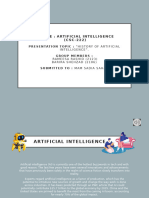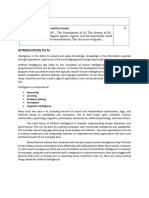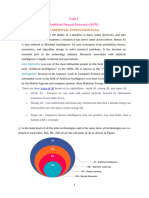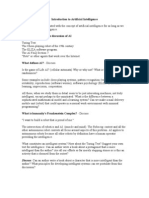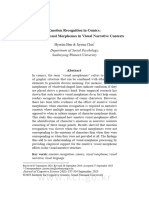0 ratings0% found this document useful (0 votes)
152 viewsPrese Nte D by Vija Yala Xmi 1NH02EC053
Prese Nte D by Vija Yala Xmi 1NH02EC053
Uploaded by
api-3760105This document provides an overview of the history and concepts of artificial intelligence (AI). It discusses:
1) The early work in AI and logic during the 1940s-1950s by researchers like Alonzo Church and Alan Turing.
2) Key terms related to AI like intelligence, knowledge, reasoning, and learning.
3) The importance of AI research grew in the late 1970s, with Japan launching a major AI program called the Fifth Generation in 1981.
4) Related fields that contribute to AI include engineering, linguistics, psychology, cognitive science, and philosophy. Fuzzy logic and neural networks are also introduced.
Copyright:
Attribution Non-Commercial (BY-NC)
Available Formats
Download as PPT, PDF, TXT or read online from Scribd
Prese Nte D by Vija Yala Xmi 1NH02EC053
Prese Nte D by Vija Yala Xmi 1NH02EC053
Uploaded by
api-37601050 ratings0% found this document useful (0 votes)
152 views15 pagesThis document provides an overview of the history and concepts of artificial intelligence (AI). It discusses:
1) The early work in AI and logic during the 1940s-1950s by researchers like Alonzo Church and Alan Turing.
2) Key terms related to AI like intelligence, knowledge, reasoning, and learning.
3) The importance of AI research grew in the late 1970s, with Japan launching a major AI program called the Fifth Generation in 1981.
4) Related fields that contribute to AI include engineering, linguistics, psychology, cognitive science, and philosophy. Fuzzy logic and neural networks are also introduced.
Original Title
AI
Copyright
© Attribution Non-Commercial (BY-NC)
Available Formats
PPT, PDF, TXT or read online from Scribd
Share this document
Did you find this document useful?
Is this content inappropriate?
This document provides an overview of the history and concepts of artificial intelligence (AI). It discusses:
1) The early work in AI and logic during the 1940s-1950s by researchers like Alonzo Church and Alan Turing.
2) Key terms related to AI like intelligence, knowledge, reasoning, and learning.
3) The importance of AI research grew in the late 1970s, with Japan launching a major AI program called the Fifth Generation in 1981.
4) Related fields that contribute to AI include engineering, linguistics, psychology, cognitive science, and philosophy. Fuzzy logic and neural networks are also introduced.
Copyright:
Attribution Non-Commercial (BY-NC)
Available Formats
Download as PPT, PDF, TXT or read online from Scribd
Download as ppt, pdf, or txt
0 ratings0% found this document useful (0 votes)
152 views15 pagesPrese Nte D by Vija Yala Xmi 1NH02EC053
Prese Nte D by Vija Yala Xmi 1NH02EC053
Uploaded by
api-3760105This document provides an overview of the history and concepts of artificial intelligence (AI). It discusses:
1) The early work in AI and logic during the 1940s-1950s by researchers like Alonzo Church and Alan Turing.
2) Key terms related to AI like intelligence, knowledge, reasoning, and learning.
3) The importance of AI research grew in the late 1970s, with Japan launching a major AI program called the Fifth Generation in 1981.
4) Related fields that contribute to AI include engineering, linguistics, psychology, cognitive science, and philosophy. Fuzzy logic and neural networks are also introduced.
Copyright:
Attribution Non-Commercial (BY-NC)
Available Formats
Download as PPT, PDF, TXT or read online from Scribd
Download as ppt, pdf, or txt
You are on page 1of 15
PRESE NTE D BY
VIJA YALA XMI
1NH02EC053
HIS TOR Y
Began during 1940’s & 1950’s.
Early work in AI
3. First there was the work of logician such as
Alonzo Church, Kurt Godel, Emil Post and
Alan Turning.
4. They were carrying on earlier work in logic
initiated by Whitehead and Russell, Tarski,
and Kleene which began in 1920’s & 1930’s.
INTRODU CTI ON
What is AI?
Motivation.
An understanding of AI requires an
understanding of related terms such as
4. Intelligence.
5. Knowledge.
6. Reasoning.
7. Thought.
8. Cognition.
9. Learning.
10. A number of computer related terms.
TH E IMPORT ANC E OF
AI
The importance of AI became apparent
to many of the world’s leading countries
during the late 1970’s.
The Japanese launched a very ambitious
program in AI research and development
called as Fifth generation in October
1981.
AI REL AT ED F IEL DS
Fields which are closely related to AI
include Engineering such as electrical
and mechanical engineering, linguistics,
psychology, cognitive science, and
philosophy and also robotics.
During the past 20 years AI has adopted
models of thinking and learning from
psychology.
INTR ODU CTI ON TO
FUZZY L OG IC
What is Fuzzy logic (FL)?
Where did Fuzzy logic came from?
How does Fuzzy logic work?
What i s F uzzy l ogic?
FL is a problem-solving control system
methodology.
It can be implemented in hardware,
software or combination of both.
FL’s approach to control problems
mimics how a person would make
decisions, only much faster.
Where d id Fuzzy lo gic
came fr om?
This concept was conceived by Lotfi Zodeh, a person
at the University of California at Barkley.
Professor Zodeh reasoned that people do not require
precise, numerical information input,& yet they are
capable of highly adaptive control.
U.S manufacturers have not been so quick to
embrace this technique while Europeans and
Japanese have been aggressively building real
products around it.
How d oes FL work?
FL requires some numerical parameters in
order to operate such at what is significant
rate of change of error.
Applied in data collection, representation
&analysis as well as classification of land,
soil & remotely sensed imagery.
KN OW LEDG E: G eneral
Concept
Definition.
Importance of knowledge.
AI has given new meaning and
importance to knowledge.
Illustration.
We are not far from the realization of this.
COMP ONENT S OF A
KNOWLED GE BA SED
SYSTEM
Different le ve ls o f
knowle dge
repre se ntatio n
ARTI FICI AL NEU RAL
NETW ORK
ANN biologically inspired as is much of
AI & based on a loose analogy of the
presumed working of a brain.
ANN consists of ‘neurons & connectors
as in neuron, structure of brain.
APPL ICATI ONS
Game playing
Speech recognition
Understanding natural language
Computer vision
Expert systems
Heuristic classification
You might also like
- Codes For All PhonesDocument54 pagesCodes For All Phonesapi-369654367% (36)
- 50 Phone Hacks DR - BradDocument29 pages50 Phone Hacks DR - Bradapi-376010558% (19)
- Study On AI - State of ArtDocument13 pagesStudy On AI - State of ArtVincent Kervyn de MeerendréNo ratings yet
- All Dos CommandsDocument5 pagesAll Dos Commandsapi-3760105100% (4)
- A Wolf by The Ears - Mattie LennonDocument19 pagesA Wolf by The Ears - Mattie LennonMirNo ratings yet
- The Canobic Inscription. Ptolemy's Earliest Work - Hamilton, Swerdlow & ToomerDocument13 pagesThe Canobic Inscription. Ptolemy's Earliest Work - Hamilton, Swerdlow & ToomerChristian BullNo ratings yet
- S/PV 1780 19 July 1974 Makarios Speech at The UN Security Council Denouncing The Coup of The Greek JuntaDocument24 pagesS/PV 1780 19 July 1974 Makarios Speech at The UN Security Council Denouncing The Coup of The Greek JuntaErato Kozakou Marcoullis100% (3)
- Unit 1Document12 pagesUnit 1AishwaryaNo ratings yet
- Artificial Intelligence - Literature ReviewDocument54 pagesArtificial Intelligence - Literature Reviewvincent john chattoNo ratings yet
- AI ApplicationsDocument13 pagesAI Applicationss10_sharmaNo ratings yet
- A.I Assignement PDFDocument15 pagesA.I Assignement PDFBara AlheehNo ratings yet
- Artificial Intelligence and Machine Learning (21CS54) Module - 1Document13 pagesArtificial Intelligence and Machine Learning (21CS54) Module - 1Balaji YalburgiNo ratings yet
- Ai PDFDocument23 pagesAi PDFsai ramNo ratings yet
- Ai PDFDocument23 pagesAi PDFsai ramNo ratings yet
- Final AIUnit 1 NotesDocument36 pagesFinal AIUnit 1 Notesomkar dhumalNo ratings yet
- CSE Artificial Intelligence ReportDocument16 pagesCSE Artificial Intelligence ReportAnonymous 22GBLsme1No ratings yet
- Embodied AI-paper - 1Document2 pagesEmbodied AI-paper - 1upspeed5050No ratings yet
- Artificial Intelligence A Modern Approach - 1Document11 pagesArtificial Intelligence A Modern Approach - 1ornek50% (2)
- Project Report ON "Artificial Intelligence"Document24 pagesProject Report ON "Artificial Intelligence"arush9211100% (1)
- Artificial Intelligence - 2Document11 pagesArtificial Intelligence - 2xoxococomeNo ratings yet
- History and Evolution of Artificial IntelligenceDocument12 pagesHistory and Evolution of Artificial IntelligenceRAGHAVENDRA VemannaNo ratings yet
- Seminar ReportDocument18 pagesSeminar ReportAll About Youtuber'sNo ratings yet
- Artificial Intelligence Author Prakhar SwarupDocument16 pagesArtificial Intelligence Author Prakhar Swarupnayakeklavya1No ratings yet
- Basic Concepts of Ai For Legal ScholarsDocument22 pagesBasic Concepts of Ai For Legal ScholarscamilaNo ratings yet
- UNIT1Document15 pagesUNIT1joshilantonyNo ratings yet
- Intelligent System: Haruki UenoDocument36 pagesIntelligent System: Haruki Uenokanchit pinitmontreeNo ratings yet
- Term Paper UNN - HENRYDocument20 pagesTerm Paper UNN - HENRYogekingsley8426No ratings yet
- Principals of AI Unit 1Document43 pagesPrincipals of AI Unit 1kanekiken31111No ratings yet
- Lesson 1 - Introduction to AIDocument27 pagesLesson 1 - Introduction to AIQuỳnh Hương ĐỗNo ratings yet
- AI 3rd LectureDocument28 pagesAI 3rd Lecturetestingpoint259No ratings yet
- What Contributes To AIDocument11 pagesWhat Contributes To AIAfeni David Akinola100% (1)
- Artificial Intelligence Unit 1 - 5Document325 pagesArtificial Intelligence Unit 1 - 5Amani yar KhanNo ratings yet
- NNFL Unit I For IV ECEDocument41 pagesNNFL Unit I For IV ECEPraneeth MNo ratings yet
- Artificial Intelligence: Enrique Peláez PH.DDocument17 pagesArtificial Intelligence: Enrique Peláez PH.DRobinson MaciasNo ratings yet
- Introduction To Artificial IntelligenceDocument8 pagesIntroduction To Artificial IntelligencePankaj SinghNo ratings yet
- Artificial Intelligence and International RelationsDocument28 pagesArtificial Intelligence and International RelationsWidya Setiabudi Aseli100% (1)
- Unit 1 AIMLDocument21 pagesUnit 1 AIMLPriyanka jadahavNo ratings yet
- Module - 1Document44 pagesModule - 1inzamamgmdNo ratings yet
- 3 Artificial IntelligenceDocument22 pages3 Artificial IntelligencePranjal TiwariNo ratings yet
- AIES - 2. Part 1Document46 pagesAIES - 2. Part 1Amit SahuNo ratings yet
- AI Notes Unit 1 PDFDocument15 pagesAI Notes Unit 1 PDFSatya NarayanaNo ratings yet
- The Story of Artificial IntelligenceDocument2 pagesThe Story of Artificial Intelligencekingkong75060No ratings yet
- Ai Unit 1 NotesDocument59 pagesAi Unit 1 Notesjaikrit2020No ratings yet
- Introduction To AI-Chapter1Document16 pagesIntroduction To AI-Chapter1shemsedin shukreNo ratings yet
- Unit 1 Introduction To AI - 12.08.2023Document51 pagesUnit 1 Introduction To AI - 12.08.2023Narendra PallavanNo ratings yet
- Unit 1 Complete NotesDocument44 pagesUnit 1 Complete Notes20bd1a058tNo ratings yet
- AIDocument30 pagesAIArmaan KhandelwalNo ratings yet
- Course: Artificial Intelligence Instructor: Naveed Kazim Khan Federal Urdu University of Arts, Science and Technology, IslamabadDocument22 pagesCourse: Artificial Intelligence Instructor: Naveed Kazim Khan Federal Urdu University of Arts, Science and Technology, IslamabadRana HafeezNo ratings yet
- Subject Name:-Artificial Intelligence Subject Code: - RCS702 Unit No.: - 1 Topic Name: - Foundations and History of ArtificialDocument22 pagesSubject Name:-Artificial Intelligence Subject Code: - RCS702 Unit No.: - 1 Topic Name: - Foundations and History of ArtificialShwetank RaiNo ratings yet
- Wa0001.Document13 pagesWa0001.vaishnavi.krNo ratings yet
- Unit - 1Document56 pagesUnit - 1298hrqr66nNo ratings yet
- AI Unit1Document23 pagesAI Unit1s98388510No ratings yet
- AI FinalDocument48 pagesAI FinalEman MetwallyNo ratings yet
- Human Level SliDocument42 pagesHuman Level SliclaricardoNo ratings yet
- Unit 1Document14 pagesUnit 1PrasadNo ratings yet
- CS2351 NotesDocument156 pagesCS2351 NotesRamshi KunnolanNo ratings yet
- Artificial Intelligence: 1 What Is AI?Document28 pagesArtificial Intelligence: 1 What Is AI?PW and AD ClipsNo ratings yet
- Fil 20240326 QPDocument9 pagesFil 20240326 QPchibrajput511No ratings yet
- Artificial Intelligence ZubiDocument35 pagesArtificial Intelligence ZubiAbdullah ShafiqNo ratings yet
- Ai Research-5-6Document2 pagesAi Research-5-6blue2badharNo ratings yet
- Unit 1Document257 pagesUnit 1jana kNo ratings yet
- RCS702 Unit1 Lecture-2Document22 pagesRCS702 Unit1 Lecture-2hasansyedamanNo ratings yet
- Iptv Final ReportDocument53 pagesIptv Final Reportapi-3743192100% (5)
- MGT503 - Principles of ManagementDocument132 pagesMGT503 - Principles of ManagementPokkiri VijayNo ratings yet
- NGN IP TV Solution ImplementationDocument10 pagesNGN IP TV Solution Implementationapi-3743192No ratings yet
- White%20 Papers%5 CIGMP%20 White%20 PaperDocument5 pagesWhite%20 Papers%5 CIGMP%20 White%20 Paperapi-3743192No ratings yet
- H264 The New MPEG Standard PDFDocument5 pagesH264 The New MPEG Standard PDFLee VanNo ratings yet
- Analyst CornerDocument19 pagesAnalyst Cornerapi-3760105No ratings yet
- Iptv TutorialDocument9 pagesIptv Tutorialapi-3743192100% (8)
- Edge TechnologyDocument28 pagesEdge Technologyapi-376010575% (4)
- Iptv ExplainedDocument4 pagesIptv Explainedapi-3743192No ratings yet
- Dna ComputingDocument25 pagesDna Computingapi-3760105100% (1)
- Electronic Weather ControlDocument11 pagesElectronic Weather Controlapi-3760105No ratings yet
- Hardcopy II Structured AsicDocument26 pagesHardcopy II Structured Asicapi-3760105No ratings yet
- Honey PotDocument20 pagesHoney Potapi-3760105100% (4)
- Multimedia CardDocument22 pagesMultimedia Cardapi-3760105No ratings yet
- Blu Ray ConstructionDocument25 pagesBlu Ray Constructionapi-3760105100% (3)
- Artificial LifeDocument31 pagesArtificial Lifeapi-37601050% (1)
- XP Problems and Their SolutionsDocument5 pagesXP Problems and Their Solutionsapi-3760105No ratings yet
- Blue EyeDocument29 pagesBlue Eyeapi-3760105100% (23)
- CryptoDocument26 pagesCryptoapi-3760105No ratings yet
- Crusoe ProcessorsDocument27 pagesCrusoe Processorsapi-3760105100% (3)
- Controller Area Network: Submitted By:Chandra Shekar.I.G Dept of E&C 1NH02EC010 NhceDocument22 pagesController Area Network: Submitted By:Chandra Shekar.I.G Dept of E&C 1NH02EC010 Nhceapi-3760105100% (2)
- CyborgsDocument19 pagesCyborgsapi-37601050% (1)
- 12c Bus ProtocolDocument33 pages12c Bus Protocolapi-3760105100% (1)
- JFKSpeech (PCQ)Document5 pagesJFKSpeech (PCQ)api-3760105No ratings yet
- Cavitation and Bubble DynamicsDocument3 pagesCavitation and Bubble DynamicsangeloplNo ratings yet
- LincolnSpeech (PCQ)Document11 pagesLincolnSpeech (PCQ)api-3760105No ratings yet
- Vitthal Ramji ShindeDocument2 pagesVitthal Ramji ShindeRajesh PuniaNo ratings yet
- Test 6Document16 pagesTest 6Ale FigueroaNo ratings yet
- Hirohito 2Document13 pagesHirohito 2Aprilia Ayu PurwatiNo ratings yet
- 109-8833 CYLINDER GP. - TILT 844 : 844H : 844K : D9R : D9T CAT 110-3269 CYLINDER GP. - LIFTDocument14 pages109-8833 CYLINDER GP. - TILT 844 : 844H : 844K : D9R : D9T CAT 110-3269 CYLINDER GP. - LIFTMuvuma JordanNo ratings yet
- ENG 2 - Vocabulary - Synonmys FinalDocument23 pagesENG 2 - Vocabulary - Synonmys FinalNarayananNo ratings yet
- Nishat Textile MillsDocument48 pagesNishat Textile MillsZubair Ghaznavi50% (2)
- BTEC Level 3 National Engineering Teaching Resource Pack Unit 1Document30 pagesBTEC Level 3 National Engineering Teaching Resource Pack Unit 1princedotty50% (2)
- Result Sheet: Govt. Polytechnic, Puri Exam:1st Semester Summer-2020 Branch:Electrical EngineeringDocument3 pagesResult Sheet: Govt. Polytechnic, Puri Exam:1st Semester Summer-2020 Branch:Electrical EngineeringRajesh Kumar MohapatraNo ratings yet
- Tab Notation LegendDocument2 pagesTab Notation LegendCamarHall100% (1)
- CBSE 10th ResultsDocument1 pageCBSE 10th Resultsnew1No ratings yet
- Magnus Credit Card For Burgundy FaqDocument20 pagesMagnus Credit Card For Burgundy FaqsaltstewieNo ratings yet
- List of Architect's For TRAINING 2016-17 - 8th SEMDocument8 pagesList of Architect's For TRAINING 2016-17 - 8th SEMEconaurNo ratings yet
- Niser SopDocument2 pagesNiser Sopabinash palaiNo ratings yet
- Hand MirrorDocument17 pagesHand Mirrorwilmer caspa carrascoNo ratings yet
- Emotion Recognition in Comics: The Effect of Visual Morphemes in Visual Narrative ContextsDocument18 pagesEmotion Recognition in Comics: The Effect of Visual Morphemes in Visual Narrative ContextsJiyung ByunNo ratings yet
- English 2Document4 pagesEnglish 2Rajarshi MahatoNo ratings yet
- Declarations of Independence Arendt and Derrida On The Problem of Founding A Republic - HonigDocument18 pagesDeclarations of Independence Arendt and Derrida On The Problem of Founding A Republic - HonigIntinion ClowngottesNo ratings yet
- WB Gateway To The World B2 Answer KeyDocument13 pagesWB Gateway To The World B2 Answer KeyCarlita-280544No ratings yet
- Maths w23 QPDocument49 pagesMaths w23 QPngocvuthanh1290No ratings yet
- Jyo Bills MergedDocument54 pagesJyo Bills MergedSrilakshmi YarrabarlaNo ratings yet
- Dan John Vernell N. Jumawan: Demonstration Teacher-ApplicantDocument9 pagesDan John Vernell N. Jumawan: Demonstration Teacher-ApplicantJonathanAmbelNo ratings yet
- Unit - 1: Analyzing Market Situation and Competitor'S StrategiesDocument53 pagesUnit - 1: Analyzing Market Situation and Competitor'S StrategiesRiya GupteNo ratings yet
- Alfresco Guide: by IT ServicesDocument15 pagesAlfresco Guide: by IT ServiceskosovianNo ratings yet
- Minutes-of-Meeting-FGD On CID Technical Assistance in MathDocument4 pagesMinutes-of-Meeting-FGD On CID Technical Assistance in MathLudivina Bernardo100% (2)
- She communicates with friendі, upload and updates his profile all the timeDocument4 pagesShe communicates with friendі, upload and updates his profile all the timeita100% (1)
- STAB27Document51 pagesSTAB27Bharani DharanNo ratings yet
- 12 SiemensDocument37 pages12 SiemensrodrigocampospkNo ratings yet






















